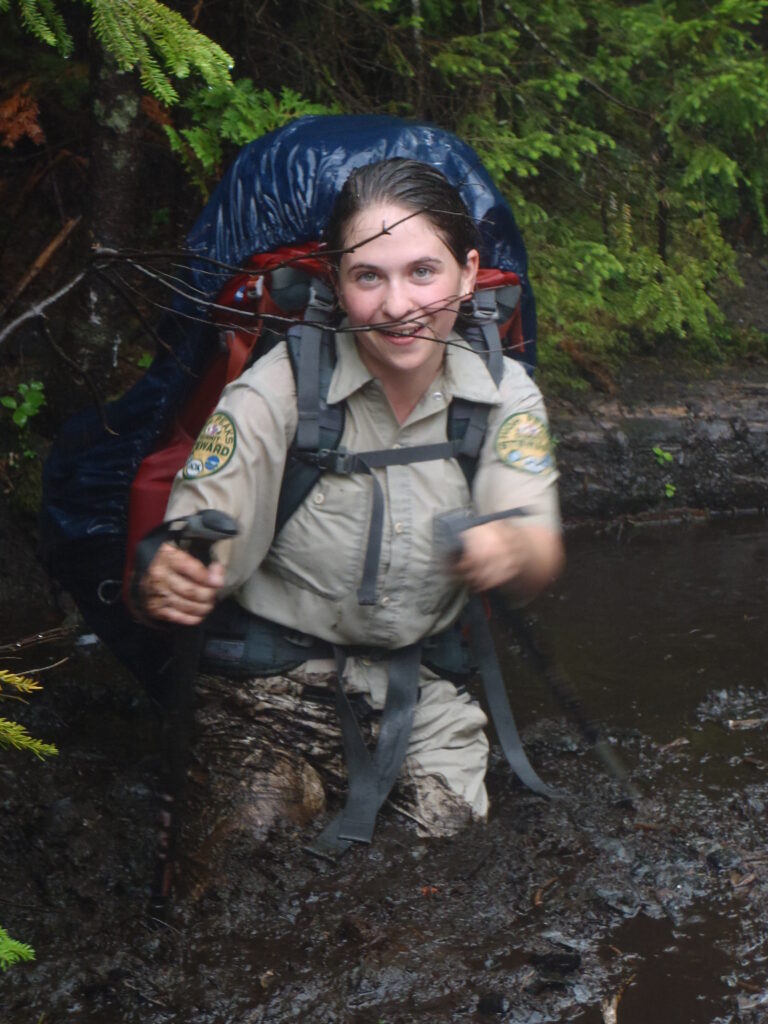Mud Season: Quick Facts
Mud Season: Quick Facts
Just what is mud season?
Running anytime from late March into mid-June—it varies each year depending on weather—mud season is when hiking trails in the Adirondacks are most susceptible to damage. Thanks to continuous waves of snow melt, mud becomes a constant on hiking trails, creating prime conditions for erosion.
As you ascend, mud turns to a range of rotten snow, ice, and deep snowpack creating challenging conditions for hikers that also raise the risk for injury. On the highest summits, alpine vegetation begins its spring growing cycle, which is a highly vulnerable time for an already vulnerable variety of plants. Stepping on these plants could kill them, so avoiding summits that they grow on at this time is important to their survival.
How to hike on a muddy trail
During mud season in the Adirondacks, it’s important to walk directly through the center of the trail. Walking around a mud puddle makes the trail—and the puddle itself—several feet wider. This can lead to vegetation damage and erosion. Muddy trails erode quickly, particularly on steep sections. Walk on rock stepping stones and bog bridges where possible.
Additionally, rainfall during mud season can create flash floods due to higher and faster water crossings. When planning your hike during mud season, look for trails with fewer water crossings. If you encounter deep or swift moving water, do not attempt to cross it.
Where should I hike?
The Department of Environmental Conservation (DEC) recommends recreators avoid trails over 2500 feet (762 meters) in elevation until mid-June. This, of course, includes all of the forty-six High Peaks, as well as numerous other trails in the High Peaks Region. However, that leaves ample opportunity to explore lower elevation peaks like Mt. Van Hoevenberg, or to visit other parts of the Adirondack Park that don’t experience snowpacks to the same degree.
It’s also a great time to explore the Catskill Park, where the soil is sandy in composition and tends to thaw and drain earlier in the spring. As always, stick to durable surfaces no matter where you go.
For hiking recommendations and up-to-date trail conditions, visit or call our High Peaks Information Center at 518-523-3441, ext. 21, or Cascade Welcome Center at 518-837-5047.

What should I wear on my feet?
Durable footwear is a must any time of the year, but wet conditions require sturdy boots to navigate safely. We recommend waterproof hiking boots that have rubber soles, as these will provide the necessary support to avoid injury. Gaiters, which are waterproof leg coverings that protect the tops of your boots, are also an important investment. They range from ankle length to mid-thigh and are great at keeping mud and water out of your boots. Trekking poles can also help you stay balanced on the trail.
Beyond these pieces of gear, you should be aware that, since snow can stick around well into May and June, snowshoes are still required to hike in places where snow is eight inches deep or greater in the Adirondacks. Snowshoes also help hikers stay on top of the rotting, collapsing snowpack so they do not sink into the deep snow. This keeps you, other hikers, and rescuers safe during this hazardous time of year.
Microspikes (or trail crampons) are also highly recommended until temperatures stay consistently above freezing on summits.
What else should I know about mud season?
Choosing not to hike on higher elevation trails during this time of year is the best thing you can do to help protect the trails you love. By giving them a chance to dry out and harden, you are protecting trailside vegetation and providing yourself and other hikers a better, less muddy experience later in the year.
Thank you for doing your part to protect the Adirondacks during mud season!
Related
High Peaks Conditions Report Disclaimer
All forms of outdoor recreation (including, but not limited to, hiking, skiing, watersports, and rock […]
Benefits of Visitor Use Management
Since the creation of some of the first parks and protected areas in the United […]
ADK Outdoor Gear Consignment Program
In 2023, Adirondack Mountain Club launched an outdoor gear consignment program at Cascade Welcome Center […]
Spring on the NPT
by Jeffrey Case In the Spring a fuller crimson comes upon the robin’s breast; In the […]

